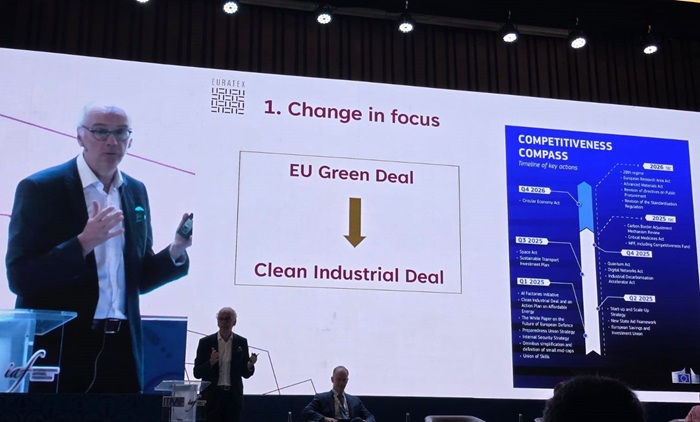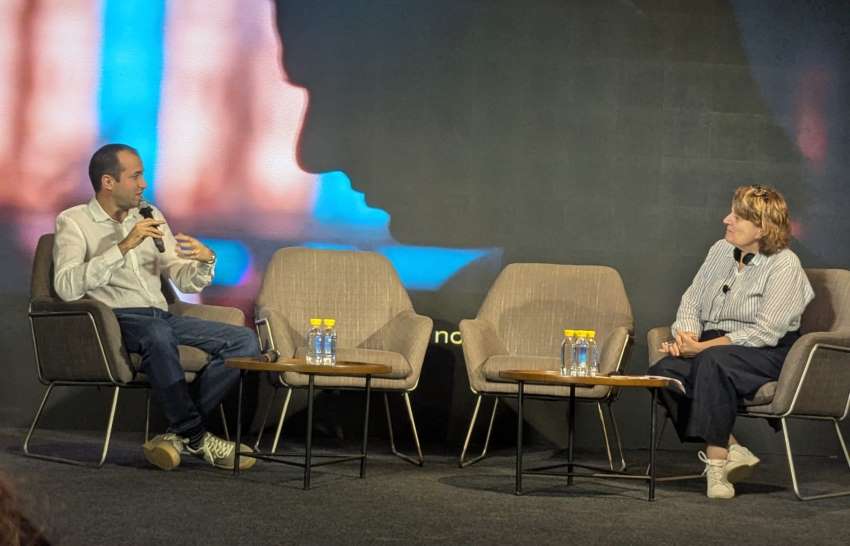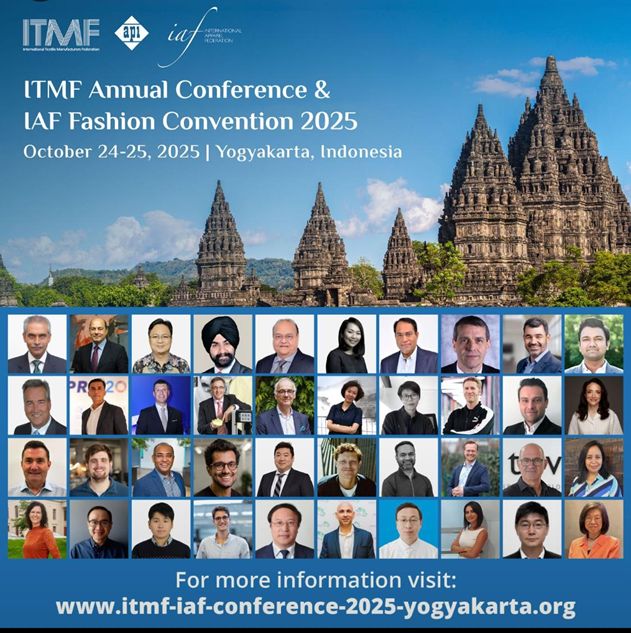FW
Pakistan has recorded a 14 per cent decline in exports of textile products during the current year. This despite the GSP Plus facility granted to Pakistan. Poor supply of gas has impacted Pakistan’s economy. While India provides subsidy on textile and wheat production, Pakistan does not. India increased its textile production three times during the last 13 years. However, in the increase in cotton production has been nominal. There is no full-time minister for the textile sector.
Pakistan is the eighth largest exporter of textile products in Asia. This sector contributes 9.5 per cent to the GDP and provides employment to about 15 million people. Pakistan is the fourth largest producer of cotton with the third largest spinning capacity in Asia after China and India, and contributes five per cent to the global spinning capacity.
Pakistan has about 1,221 ginning units, 442 spinning units, 124 large spinning units and 425 small units which produce textile products. Machinery in textile universities may be upgraded so that engineers get trained. The government may provide more incentives to Karachi, Faisalabad and Lahore textile cities and encourage small capitalists to invest there. Efforts are being made to increase collection under the textile cess.
The Oeko-Tex system focuses on safety at the workplace and compliance with UN conventions on human rights and ILO core labor standards. A transparent assessment system is used to demonstrate to companies where there is need for optimisation on the path towards best practice in terms of sustainability.
The criteria applied for testing textiles for harmful substances to Oeko-Tex standard 100 are tightened up on a yearly basis. The Oeko-Tex concept offers a range of solutions in terms of product stewardship. This includes chemicals or environmental management systems conforming with ZDHC and DETOX, which ensure transparent monitoring of the objectives defined in each case.
The Oeko-Tex system delivers practical answers to inform all stakeholder groups about advances and new developments in the textile sector. In this context the MySTeP database allows companies to map the sustainability of their supply chain at a b2b level using key performance indicators so monitoring, improving and driving forward this aspect with targeted measures.
In conjunction with the consumer label Made in Green by Oeko-Tex this permits branded and retail companies to directly advertise on the product itself that it has been manufactured under environmentally friendly and socially responsible conditions.
https://www.oeko-tex.com/
US apparel companies are increasingly looking away from China and sourcing from countries such as Vietnam, India, Bangladesh and Indonesia. Vietnam is the biggest beneficiary of changed sourcing. Bangladesh remains the most popular sourcing destination, but continues to face major challenges. It has to compete with other leading suppliers in the region, particularly Vietnam, India and Indonesia.
For the Trans-Pacific Partnership (TPP), the US apparel industry is seen as a critical stakeholder. Many US apparel companies source from Vietnam, Peru, Mexico and Malaysia and expect TPP’s implementation to impact business practices. They are likely to source more textiles and apparel from TPP partners following the implementation of the agreement, or strategically adjust or redesign their supply chain based on TPP.
The one sticking point, however, is the restrictive rules in the agreement, which companies believe could limit its potential. They want the short-supply list to be expanded. The proposed yarn-forward rule of origin is also cited as a major hurdle to the industry realising real benefits from TPP.
US fashion companies are continuing to express interest in expanding sourcing in the US over the next two years as they diversify their sourcing. However, there is no evidence companies are actually shifting their business models back to manufacturing.
The garment industry, which is reeling under a severe cash crunch, has recovered Rs 400 crores in the last three months from retailers who had defaulted on payment due to weak demand. The Clothing Manufacturers’ Association of India (CMAI) has formed a separate committee to negotiate with retailers and recover dues. The association has also formed a system to alert members on the credit profile of buyers so that they do not fall prey to wilful defaulters.
CMAI’s recovery committee has taken up long-pending cases and is negotiating recovery of Rs 1,000 to Rs 1,500 crores. The domestic organised garment sector registered a growth of 12 per cent to Rs 44,800 crores last fiscal against a growth of seven per cent in fiscal 2013-14.
CMAI was entrusted with setting up 50 skill centers across India by March 2017 and train 35,000 workers. It has already opened 35 apparel training centers in Andhra Pradesh, Gujarat, Karnataka, Tamil Nadu, Telengana and Maharashtra in the last four months. Centers are coming up at Vasai, Umargaon and Vapi-Daman. Skill centers are planned near the apparel industry so that trained people can be employed immediately.
Maharashtra is set to accept some of the major recommendations proposed by the Suresh Halwankar Committee in its report on the new Textile Policy of Maharashtra. The textile sector is the second largest employer, after agriculture, in Maharashtra. At present, over 30 lakh people are directly employed and two crore are indirectly employed in the industry.
The committee has recommended sick cooperative cotton mills be handed over to the private sector for good. Five mega textile hubs are to be developed and foreign direct investment be attracted to the textile industry. It specifies Amravati be developed as a spinning hub, Nagpur as a knitting hub, Solapur as a terry towel hub and Ichalkaranji as a suiting-shirting-denim mega composite textile hub. These hubs are to have all facilities, along with a common effluent treatment plant and water recycling plants in the vicinity, thus cutting down on cost and the time of making garments from cotton drastically.
The committee hailed China's textile policy and suggested a fiber to fashion approach to turn around the sector, which was once blooming in the state. It also seeks to reduce the power tariff for the sector, while encouraging setting up of more spinning and processing plants in the state.
WTO, the World Trade Organisation, has launched a new website which will serve as a focal point for members, donors, and others seeking information on the new Trade Facilitation Agreement Facility (TFAF)
TFAF was created at the request of developing country and least-developed country (LDC) members to help ensure that they receive the assistance needed to reap the full benefits of the Trade Facilitation Agreement and to support the ultimate goal of full implementation of the new agreement by all members.
The TFAF will support these countries in assessing their specific needs and identifying possible development partners to help them meet those needs through a diverse number of activities.
The website can be accessed in English, French and Spanish.
Developing and LDC members must notify the WTO which provisions they will implement when the agreement enters into force or, in the case of LDCs, within one year after entry into force (Category A commitments); which provisions they will implement after a transitional period following the entry into force of the agreement (Category B); and which provisions they will implement on a date after a transitional period following the entry into force of the agreement and that require the acquisition of assistance and support for capacity building (Category C).
Nearly 700 exhibitors are confirmed to participate in Shenzhen International Trade Fair for Apparel Fabrics and Accessories. They will offer buyers a wide selection of high quality ladies’ wear, casual wear and suiting fabrics, as well as the latest knits, lace and embroidery, yarns and fibers and accessories. The event will be held in China, July 9 to 11, 2015.
In addition to a wide range of mainland Chinese exhibitors, suppliers from Hong Kong, India, Japan, Korea, Taiwan and the UK will feature. Korea, China and Taiwan will have pavilions.
This year’s Taiwan pavilion will feature a wide range of options from raw materials to fabrics, including high end jacquard fabrics, lace, print and knitted fabrics, computer embroidered items, high-end tencel cotton and linen, plain weave linen, knits, denim and more. A number of exhibitors will also showcase functional textiles from Taiwan. .
The concurrent 15th China (Shenzhen) International Brand Clothing & Accessories Fair, a fashion garment event, will also provide buyers with even more sourcing options.
Intertextile Pavilion is now at a stage in its development where the main textile manufacturers in South China gather there. With the up, mid and downstream sectors of the industry all present, it is an exhibition with a lot of opportunities and a focus on conducting business onsite. What’s more, with Hong Kong adjacent, international brands which have buying offices there will attend the fair to find the latest fashion trends and novel fabrics.
.
Intertextile Pavilion Shenzhen is organised by Messe Frankfurt (HK) Ltd; the Sub-Council of Textile Industry, CCPIT; the China TextileInformation Centre and the Shenzhen Garment Industry Association.
intertextile-pavilion-shenzhen.hk.messefrankfurt.com/
Implementing the World Trade Organisation’s Trade Facilitation Agreement (TFA) could reduce worldwide trade costs by anywhere from 12.5 per cent to 17.5 per cent, with the greatest benefits accruing to developing countries.
Countries which implement the TFA in full will reduce their trade costs by anywhere from 1.4 to 3.9 percentage points more than those that only implement the minimum requirements. The greatest opportunities for reductions in trade costs are in low and lower middle income countries.
For producers of goods and services, full implementation will lift export performance and lower the costs of imports. These lower costs will eventually be passed onto consumers, especially those in countries that can afford these imports the least. Trade costs include all tariff and non-tariff costs including transport, border-related and local distribution costs from foreign producer to final user in the domestic country.
The TFA creates a significant opportunity to improve the speed and efficiency of border procedures, thereby reducing trade costs and enhancing participation in the global value chains that characterise international trade.
As G20 economies seek to achieve an additional two per cent of GDP growth by 2018, facilitating a more open flow of goods and services across international borders can be a key contributor to this target. The new trade facilitation indicators help countries benchmark their performance and identify areas of priority action where great rewards can be reaped with little effort.
https://wto.org/tradefacilitation
FESPA China will take place October 21 to 23, 2015.Under the theme Find Your Key To Success, the third edition of FESPA China will provide visitors with inspiration and skills to unlock their business potential through industry launches, product innovation and content led features.
FESPA engages with a broad cross-section of the Chinese market and attracts a high number of global exhibitors and visitors. It has defined its market position as a key regional event for the major brands.
Over 9,500 visitors attended the inaugural FESPA China 2013 exhibition from 77 countries. In 2014, attendance grew to 15,166 from 91 countries, cementing FESPA China’s position as a regional event.
After mainland China, the largest visitor delegations were from India, Japan, Korea and Malaysia, with printers also travelling from Hong Kong and Taiwan as well as Australasia, Europe, USA, Africa and South America.
The event which will be held in partnership with China Screen Printing and Graphic Imaging Association is expected to fill over 12,000 sq meters of floor space, up 13 per cent over the 2013 edition.
International exhibitors confirmed for this year’s event include Kornit, Siser, Dgen, Mimaki, Keundo, Asialink and Synnex. Local participants include Denishi Denbishi Fine Chemical, Ever-Bright Printing Machine, Shenyang Shicheng Printing Machinery, Dongguan and Suzhou Yihui Printing Machinery Factory etc.
www.fespa.com/calendar/fespa-events/fespa-china-2015.html
There is a feeling India's foreign trade policy will affect exports of value added products like cotton dyed and printed fabrics and made-ups to African countries.The policy has scrapped benefits on exports to African countries. Exporters have urged the government to include exports of value added products to Africa.
The newly introduced MEIS (Merchandise Exports from India Scheme) has allowed a duty credit scrip of two per cent, three per cent and five per cent to exports of notified products to certain specified countries. However, the scheme does not include exports of value added and labor intensive products like cotton dyed and printed fabrics and made-ups.
In India’s earlier foreign trade policy, exports of cotton fabrics and made- ups to many African countries were granted duty credit scrip at four per cent of the FOB value of exports in general and in some cases seven per cent.
Exporters say the share of textile exports to the African region is less than five per cent and there is huge potential to increase this share if adequate export benefits are extended.
Indian exports go to African countries like Mauritania, Mali, Angola, Senegal, Togo, Ghana, Kenya and Tanzania.












